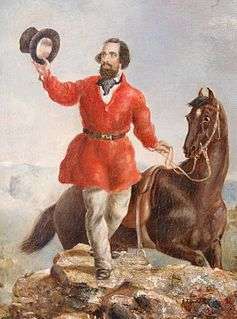Edward Hargraves
| Edward Hammond Hargraves | |
|---|---|
|
returning the salute of the gold miners (February 12, 1851) by Thomas Tyrwhitt Balcombe | |
| Born |
7 October 1816 Gosport, Hampshire England |
| Died |
29 October 1891 (aged 75) Sydney |
| Nationality | British |
| Occupation | Commissioner of Crown Lands |
| Known for | Australian gold rush |
Edward Hammond Hargraves (7 October 1816 – 29 October 1891) was a gold prospector who claimed to have found gold in Australia in 1851, starting an Australian gold rush.
Life and career
Edward Hamond Hargraves was born at Gosport, Hampshire, England, the third son of Lieutenant John Edward Hargraves and his wife Elizabeth Hargraves. He was educated at Brighton Grammar School in England and Lewes. He travelled to California during the California Gold Rush, but his prospecting there was not successful. On 12 February 1851 he, with John Lister, found five specks of gold in Lewis Ponds Creek in New South Wales in Australia. Enlisting the help of others to continue the search, he returned to Sydney in March to interview the Colonial Secretary, and, encouraged by his friends at Bathurst, wrote to the Sydney Morning Herald describing the rich fields.[1]
Hargraves was rewarded by the New South Wales Government for his find – he was paid £10,000 and was appointed Commissioner of Crown Lands. The Victorian Government paid him £5,000. He only claimed £2,381 before the funds were frozen after James Lister protested. An enquiry was held in 1853 which upheld that Hargraves was the first to discover the goldfield. The goldfield was then named Ophir.[1]
In 1856, Hargraves purchased a 640-acre (2.6 km2) landing at Budgewoi on the Central Coast of New South Wales. He went on to build "Norahville" at Noraville. Wollombi Aboriginal Tribe members are known to have worked on the property. Some sources state that Hargraves had "befriended" the Aboriginal tribe members.
In 1877, Hargraves was granted a pension of £250 per year by the Government of New South Wales, which he received until his death. Shortly before his death in Sydney on 29 October 1891, a second enquiry found that John Lister and James Tom had discovered the first goldfield.[1] Lister is buried in the cemetery at Millthorpe, NSW and Tom at Byng, NSW, both within 20km of Ophir.
Hargraves wrote a book about his discovery titled Australia and its Goldfields: a historical sketch of the Australian colonies from the earliest times to the present day with a particular account of the recent gold discoveries, published in 1855.
References
Notes
- 1 2 3 Mitchell 1972.
Bibliography
- Evans, Joe. 1988 Gold Gem and Treasure
- Hodge, Brian. "Hargraves, Edward Hammond (1816–1891)". Oxford Dictionary of National Biography (online ed.). Oxford University Press. doi:10.1093/ref:odnb/12314. (Subscription or UK public library membership required.)
- Mennell, Philip (1892). "
 Hargraves, Edward Hammond". The Dictionary of Australasian Biography. London: Hutchinson & Co. Wikisource
Hargraves, Edward Hammond". The Dictionary of Australasian Biography. London: Hutchinson & Co. Wikisource - Mitchell, Bruce (1972). "Hargraves, Edward(1816–1891)". Australian Dictionary of Biography. Canberra: Australian National University. Retrieved 15 March 2008.
- Serle, Percival. "Hargraves, Sir Edward Hammond (1816–1891)". Dictionary of Australian Biography. Project Gutenberg Australia. Retrieved 15 February 2007.
-
 Seccombe, Thomas (1901). "Hargraves, Edward Hammond". In Sidney Lee. Dictionary of National Biography, 1901 supplement. London: Smith, Elder & Co.
Seccombe, Thomas (1901). "Hargraves, Edward Hammond". In Sidney Lee. Dictionary of National Biography, 1901 supplement. London: Smith, Elder & Co.
